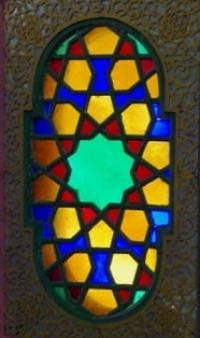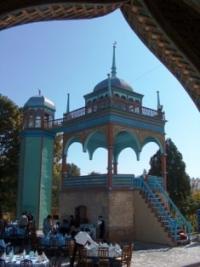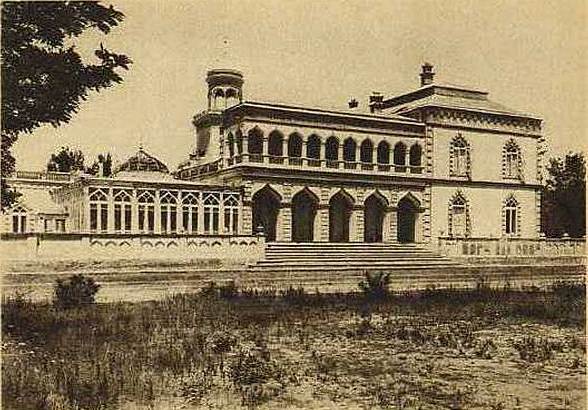You are here
Sitorai Mokhi-Khosa Palace.


Tours on monuments of antiquities of Bukhara province.
“Till the smoke of the joss-house glorify,
About heaven and hell to interpret?
Look at the boards of fate, there since ancient times
All that is supposed to be written"
Omar Khayyam.
Excursion to Sitorai Mokhi-Khosa Palace.
Sitorai Mokhi-Khosa Palace was a country residence of Bukhara emirs. It had been under construction for two decades beginning from the end of 19th century. Construction works at the old palace started at emir Abdullakhadkhan.
He sent Bukharian masters to Petersburg and Yalta for study of Russian architecture there. Using Russian experience, local architects at the head of the master Khodja Hafiz built great building that combined local Bukharian and European traditions.
Its throne hall for royal receptions made a core of the palace. During the meetings, court elite stayed here under the arches of the throne hall. A new palace complex Sitorai Mokhi-Khosa was fully constructed at emir Alimkhan.
It included a grand entrance arch decorated with mosaic, courtyard with galleries, the main building in European style with greenhouse before the pool and the house of emir's harem situated deep in the garden.
There are two marble lions sitting at the entrance of the main building made by local masters of Nurata. The main gate is a puny but very garish mockery of every great pishtak in Bukhara and Samarkand.
It leads to a modest courtyard sacrificed to the hard sell of mass-produced silk dressing gowns, which in turn leads to Said Alim Khan's palace-within-a-palace round three sides of a larger yard.
Named after him and finished in 1917, this is now a branch of Bukhara's History Museum. Honoured guests were received in the White Hall, which forms the west side of the yard and was decorated by a master stucco plasterer called Usto Shirin Muradov whose picture hangs by the entrance and whose hands were maimed on the khan's orders when his work was done-either for some trifling error or so he could not reproduce the design anyone else.
The ornate plasterwork in the hall, like most interior decor in the palace, originally had a generous garnish of gold leaf which was taken by the and replaced with bronze. The fireplace in the chess room round the corner to the left is German; the silver boxes and fish are genuine antique Bukharan.
Red and blue banqueting halls follow, the first with red lighting, blue stained glass and a fine collection of daggers; the second, equally nauseating, has a mirror which reflects you 40 times.
The ordeal by psychedelia ends,when you reach the emir's chakhana, more window than wall, containing his ancestor priceless collection of Chinese vases. A paved walkway leads from the male playground to the female.
So, reputedly, did a secret tunnel for the exclusive use of the voyeuristic emir. Beside a large khauz now over- looked by the neurological sanatorium is a two-storey building, more European than in style, where the emir's begums used to live.
The harem was said to number 400 by 1920, when M. N. Roy, an Indian member of the Central Asiatic Bureau of the Comintern decreed a mass divorce and allowed Red Army troops in to take their pick.
Recording to his own account, quoted by Moor house. The storming of the harem took place under strict vigilance, and nothing unpleasant happened. The begums, of course, behaved like scared rabbits, but the sight of the husky young men scrambling for them must have made some impression on them. Able-bodied young men seeking their favour was a new experience to women whose erotic life could naturally not be satisfied by a senile old man.
At the end it was a pleasing sight-the secluded females happily allowing themselves to be carried away by proud men. In the official guesthouse, discreetly separate from both palace and harem, there is a collection of royal robes which is outshone by the one in the Tashkent Museum of Art though the spare room itself must have rivalled any in the world for sheer extravagance.
There were 4.5 kilos of gold on its walls. Sitorai Mokhi-Khosa Palace was a country residence of Bukhara emirs. It had been under construction for two decades beginning from the end of XIXth century.
Construction works at the old palace started at emir Abdullakhadkhan. He sent Bukharian masters to Petersburg and Yalta for study of Russian architecture there. Using Russian experience, local architects at the head of the master Khodja Hafiz built great building that combined local Bukharian and European traditions. Its throne hall for royal receptions made a core of the palace.
During the meetings, court elite stayed here under the arches of the throne hall. A new palace complex Sitorai Mokhi-Khosa was fully constructed at emir Alimkhan. It included a grand entrance arch decorated with mosaic, courtyard with galleries, the main building in European style with greenhouse before the pool and the house of emir's harem situated deep in the garden.
There are two marble lions sitting at the entrance of the main building made by local masters of Nurata.

Authority:
V.G Saakov «History of Bukhara». Publishing house "Shark", 1996. «Bukhara. Masterpieces of the Central Asia». The historical guidebook across Bukhara. 2012. "Bukhoro. Bukhara" In the Uzbek, English and Russian languages. Publishing house "Uzbekistan", Tashkent 2000. Mukhammad Narkshakhi. History of Bukhara. Tashkent. 1897 (translator N.Lykoshina). V.G.Saakov "Architectural masterpieces of Bukhara. A Bukhara regional society "Kitabhon" Uzbek SSR, Exactly 1991 Robert Almeev. "History of ancient Bukhara". (Under edition of the Academician of the Academy of sciences of Republic Uzbekistan of Rtveladze E.V.).
Photos
Alexander Petrov.







